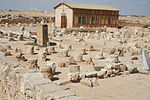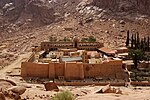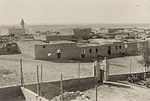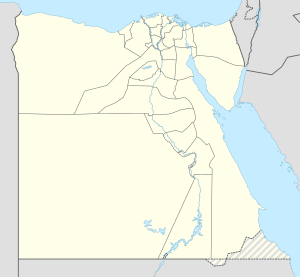The United Nations Educational, Scientific and Cultural Organization (UNESCO) World Heritage Sites are places of importance to cultural or natural heritage as described in the UNESCO World Heritage Convention, established in 1972.[1] Cultural heritage consists of monuments (such as architectural works, monumental sculptures, or inscriptions), groups of buildings, and sites (including archaeological sites). Natural features (consisting of physical and biological formations), geological and physiographical formations (including habitats of threatened species of animals and plants), and natural sites which are important from the point of view of science, conservation, or natural beauty, are defined as natural heritage.[2] Egypt accepted the convention on 7 February 1974 , making its historical sites eligible for inclusion on the list. There are seven World Heritage Sites in Egypt, and a further 34 sites on the tentative list.[3]
First sites in Egypt were listed in 1979, when five properties were inscribed. Since then, two more sites have been listed, Saint Catherine Area in 2002 and Wadi al Hitan in 2005. The latter is also the only natural site in Egypt, the other sites are listed for their cultural properties.[3] One of the key events that triggered the development of the World Heritage Convention was related to Egypt. Following the decision to construct the Aswan Dam on the Nile which would result in flooding of numerous archaeological sites in Lower Nubia, an international campaign was launched in 1959 to preserve the sites by dismantling them and reassembling them at safe locations.[4] One site in Egypt is currently listed as endangered. Abu Mena was listed in 2001 because the rising water table is decreasing the stability of clay-based soils, resulting in threats to structural integrity of the monuments.[5] Egypt has served on the World Heritage Committee five times.[3]
World Heritage Sites
[edit]UNESCO lists sites under ten criteria; each entry must meet at least one of the criteria. Criteria i through vi are cultural, and vii through x are natural.[6]
| Site | Image | Location (governorate) | Year listed | UNESCO data | Description |
|---|---|---|---|---|---|
| Memphis and its Necropolis – the Pyramid Fields from Giza to Dahshur | 
|
Giza | 1979 | 86; i, v, vi (cultural) | Memphis was the capital of the Old Kingdom of Egypt and was founded around 3000 BCE. Its most important temple was dedicated to Ptah. The Pyramid fields comprise some of the main clusters of Egyptian pyramids, including the Giza pyramid complex (pictured) with the Great Pyramid of Giza (the only one surviving of the Seven Wonders of the World) and the Great Sphinx, pyramids at Dahshur, the complex at Saqqara, and the complex at Abusir. There are more than 38 pyramids in the area, as well as their architectural predecessors, mastabas, rock tombs, and temples.[7] |
| Ancient Thebes with its Necropolis | 
|
Luxor | 1979 | 87; i, iii, vi (cultural) | Thebes was the capital of Egypt for long periods during the Middle Kingdom and New Kingdom eras. It was the holy city of Amun and the religious capital for most of Egypt's history. Main monuments date from the period from 1500 to 1000 BCE and include colossal temples at Karnak and Luxor (pictured) and royal tombs in the Valley of the Kings and the Valley of the Queens. Some of the best known are the Mortuary temple of Hatshepsut and the Tomb of Tutankhamun.[8] |
| Nubian Monuments from Abu Simbel to Philae | 
|
Aswan | 1979 | 88; i, iii, vi (cultural) | This site comprises ten monuments from different periods of Egyptian history that were relocated in an international campaign from the 1960s to 1980s to save them from the rising waters of the Nile, following the construction of the Aswan Dam. The monuments are: Abu Simbel (commissioned by Ramesses II, relocation pictured), New Amada, New Wadi Sebua, New Kalabsha, Philae temple complex (Agilkia Island, from Greco-Roman period), Qubbet el-Hawa (Old and Middle Kingdom Tombs), Ruins of town of Elephantine, Stone quarries and Unfinished obelisk, Monastery of St. Simeon, and Fatimid Cemetery.[9] |
| Historic Cairo | 
|
Cairo | 1979 | 89; i, v, vi (cultural) | Cairo was founded as the seat of the Fatimid Caliphate in the 10th century on the site of earlier cities. It was a major city during the Islamic Golden Age and beyond, with scholars, scientists, medical doctors, artists, writers, and traders living there or visiting. As the construction shifted to other parts of the city in the 19th century, the historical part is well preserved and features ensembles of Tulunid, Fatimid, and Mamluk buildings, including the Mosque of Ibn Tulun from the 8th century, numerous shrines, madrasas, hammams, and fountains.[10] |
| Abu Mena† | 
|
Alexandria | 1979 | 90; iv (cultural) | The Early Christian centre developed around the tomb of Menas of Alexandria who died in 296. The site was a pilgrimage centre in Classical antiquity and remained important for the Coptic community in the following centuries. The archaeological site comprises a church, a baptistery, basilicas, public buildings, streets, monasteries, houses, and workshops. Main buildings were constructed in ashlar limestone while simple houses were in mudbrick. The site has been listed as endangered since 2001 because the rising water table is decreasing the stability of clay-based soils, resulting in threats to structural integrity of the monuments [11][5] |
| Saint Catherine Area | 
|
South Sinai | 2002 | 954; i, iii, iv, vi (cultural) | The Orthodox monastery of Saint Catherine was founded in the 6th century and is the oldest Christian monastery still in function. It was built at the site of what is traditionally believed to be Mount Horeb - the place where, according to the Old Testament, Moses received the Tablets of the Law. The region is sacred for Christians, Muslims and Jews. The monastery hosts exceptional examples of Byzantine art, as well as collections of manuscripts.[12] |
| Wadi Al-Hitan (Whale Valley) | 
|
Faiyum | 2005 | 1186; viii (cultural) | Wadi Al-Hitan is the most important fossil site to study the evolution of cetaceans from terrestrial to marine mammals. Excavations have uncovered numerous often complete fossils of the earliest order of whales, archaeoceti, in the last stages of losing their hind limbs. The site also provides clues about the environment these animals lived in.[13] |
Tentative list
[edit]In addition to sites inscribed on the World Heritage List, member states can maintain a list of tentative sites that they may consider for nomination. Nominations for the World Heritage List are only accepted if the site was previously listed on the tentative list.[14] Egypt maintains 34 properties on its tentative list.[3]
| Site | Image | Location (governorate) | Year listed | UNESCO criteria | Description |
|---|---|---|---|---|---|
| Siwa archaeological area | 
|
Matrouh | 1994 | (cultural) | Siwa Oasis contains several archaeological sites, including the oracle temple of Amun.[15] |
| Temple of Serabit Khadem | 
|
South Sinai | 1994 | (cultural) | This nomination comprises Temple of Serabit Khadem and Saint Catherine's Monastery, the latter has been listed as a World Heritage Site in 2002.[16] |
| North Sinai Archaeological Sites Zone | North Sinai | 1994 | (cultural) | The land bridge between Egypt and Canaan has been an important route for military expeditions in both ways through history. It comprises a collection of ancient sites between the Suez Canal and Gaza along the Mediterranean coast.[17] | |
| Temple of Hator built by Ramses III | 1994 | (cultural) | No information provided in the nomination documentation.[18] | ||
| Dahshour archaeological area | 
|
Giza | 1994 | (cultural) | Dahshur was a part of the Memphite Necropolis that has been listed as a World Heritage Site since 1979. It was first used by Sneferu of the Fourth Dynasty who constructed the Bent Pyramid (pictured). It was later used by the pharaohs of the Middle Kingdom.[19] |
| El Fayoum | 
|
Faiyum | 1994 | (cultural) | This nomination comprises sites such as Kom Aushim (Karanis), Dimai (Soknopaiou Nesos, pictured), Qasr Qarun (Dionysias), Batn I hrit (Theadelphia), and Byahma-Medinet el Fayoum.[20] |
| El-Gendi Fortress | South Sinai | 1994 | (cultural) | The fortress was constructed under Saladin in 1183 on a mountain at the height of 2,150 m (7,050 ft). It has several towers, two mosques, and rooms for soldiers.[21] | |
| Rutho Monastery | South Sinai | 1994 | (cultural) | The ruins of a 6th century monastery were discovered in 1984. The complex contained two basilicas, an oil press, rooms for monks, and was surrounded by defensive walls.[22] | |
| Wadi Feiran | South Sinai | 1994 | (cultural) | Feiran Oasis has remains of old monasteries and churches, as well as rocks with Nabataean inscriptions.[23] | |
| Pharaon Island | 
|
South Sinai | 1994 | (cultural) | The island is situated on a strategic location in the Gulf of Aqaba. It has structures from different periods, including a fortress built under Saladin to protect the trade routes.[24] |
| Dahab | South Sinai | 1994 | (cultural) | In Dahab, there are remains of a Byzantine lighthouse and remains of a settlement from the 5th and 6th centuries.[25] | |
| Minia | 
|
Minya | 1994 | (cultural) | This nomination comprises the tombs of Beni Hasan, tombs of Tell El-Amarna, Hermopolis, and Tuna El-Gebel sites (pictured).[26] |
| Newibah castle | South Sinai | 1994 | (cultural) | The castle from 1893 was constructed on the site of an older castle from the Ayyubid period.[27] | |
| Ras Mohammed | 
|
South Sinai | 2002 | vii, viii, ix, x (natural) | The area comprises desert on land and a marine habitat with coral reefs rich in animal species. There are also sites with fossil corals.[28] |
| Gebel Qatrani Area, Lake Qaroun Nature Reserve | 
|
Faiyum | 2003 | (mixed) | The quarries around Lake Qaroun (on the site of the ancient Lake Moeris) were already in use in the Predynastic period (4th millennium BCE) and stone from here was used in temples of the Old Kingdom. Excavations have also uncovered Neolithic stone tools and remains of an ancient proboscidean, Moeritherium.[29] |
| Southern and Smaller Oases, the Western Desert | 
|
Beheira, Matrouh, New Valley | 2003 | vii, viii, ix, x (natural) | This nomination comprises five sites in the Western Desert: Kharga Oasis, Dakhla Oasis (pictured), Moghra Oasis, Dunqul Oasis, and the Wadi El Natrun depression. These sites have been inhabited since ancient times. People grow date palms, olives, fruit trees, as well as some cereals. There are several xerophytic and halophytic plant species. The area is also home to dorcas gazelle.[30] |
| Bird Migration Routes | 
|
Aswan, North Sinai, Red Sea | 2003 | vii, x (natural) | This nomination comprises five sites: Lake Bardawil (pictured) and Zaranik on the Mediterranean coast, the Gabal Sha'ib El Banat area on the Red Sea coast, and Saluga and Ghazal Islands and the Lake Nasser on the Nile. These sites are important stopovers for migratory birds, as well as for the resident ones.[31] |
| Desert Wadis | 
|
Aswan, Red Sea | 2003 | vii, viii, ix, x (natural) | This nomination comprises three desert wadis: Wadi Allaqi, Wadi El Gemal, and Wadi Qena. They were river valleys during the humid periods. They are nominated due to historical remains spanning from prehistory to Roman Egypt, as well as biodiversity. El Gemal (pictured) is located at the Red Sea coast and is an important stopover for migratory birds, a nesting site for green turtles, and a habitat for dugong. [32] |
| Mountain Chains | 
|
Aswan, New Valley, Red Sea | 2003 | vii, viii, ix, x (natural) | This nomination comprises five areas with mountain chains that reach at some points above 2,000 m (6,600 ft). They are nominated due to the geological formations they exhibit, their plant and animal life, and some sites have prehistoric petroglyphs. Gilf Kebir is pictured.[33] |
| Great Desert Landscapes | 
|
Beni Suef, Matrouh | 2003 | vii, viii, ix (natural) | This nomination comprises three sites: the Qattara Depression, a depression with various geomorphological land formations, the Great Sand Sea (pictured), which is a vast expanse of sandy dunes, and the Sannur Cave area, where alabaster was mined in ancient times.[34] |
| Alexandria, ancient remains and the new library | 
|
Alexandria | 2003 | i, ii, vi (cultural) | Alexandria was founded in 332 BCE by Alexander the Great and was an important centre of arts and learning in Classical Antiquity, with famous structures such as the Lighthouse of Alexandria and the Great Library. The existing monuments include Pompey's Pillar (pictured), Serapeum, several tombs, and underwater remains. A new modern library was inaugurated in 2002.[35] |
| Abydos, city of pilgrimage of the Pharaohs | 
|
Sohag | 2003 | iv, vi (cultural) | Abydos was declared the city of Osiris, god of the afterlife, under Intef II of the Eleventh Dynasty. Due to its significance as a cult site, numerous pharaohs visited the city and constructed temples there, including Seti I and Ramesses II (temple pictured). There are necropolises from various periods around the city.[36] |
| Pharaonic temples in Upper Egypt from the Ptolemaic and Roman periods | 
|
Aswan, Luxor, Qena | 2003 | iv (cultural) | This nomination comprises four temples that were built in the Ptolemaic and Roman periods, with some incorporating components of earlier structures. The temples are the Dendera Temple complex (Temple of Hathor pictured), Temple of Kom Ombo, Khnum Temple in Esna, and the Temple of Edfu.[37] |
| Necropolises of Middle Egypt, from the Middle Empire to the Roman period | 
|
Minya | 2003 | ii, iii, vi (cultural) | This nomination comprises the tombs of Beni Hasan (pictured), tombs of Tell El-Amarna, Hermopolis, and Tuna El-Gebel sites. They mainly date from the Middle Kingdom to the Roman period. Many tombs are decorated with paintings, carvings, and statues.|[38] |
| Raoudha nilometre in Cairo | 
|
Cairo | 2003 | i, iv (cultural) | A nilometer was a structure for measuring the Nile River's clarity and water level during the annual flood season. The structure on Roda Island dates to the early 8th century and was renovated several times. It has a three storey well and a marble pillar to monitor the water level.[39] |
| The monasteries of the Arab Desert and Wadi Natrun | 
|
Beheira, Suez | 2003 | ii, iv, v (cultural) | This nomination comprises two groups of Coptic Orthodox monasteries, one group in Wadi El Natrun and the other in the Eastern Desert. The oldest one is the Monastery of Saint Anthony, associated with the monk Saint Anthony, one of the founders of Christian monasticism at the end of the 3rd century. Other monasteries include Monastery of Saint Paul the Anchorite, Monastery of Saint Pishoy, Monastery of Saint Macarius the Great, and the Monastery of Saint Mary Deipara (pictured).[40] |
| Two citadels in Sinai from the Saladin period (Al-Gundi and Pharaoh's island) | 
|
South Sinai | 2003 | iv, vi (cultural) | The two fortresses, one in Al-Gundi and the other one on the Pharaoh's Island (pictured), were constructed in the 12th century under Saladin. They were strategic forts during the Crusades but lost importance after 1291 and were later abandoned. Parts of the forts have been well preserved.[41] |
| The An-Nakhl fortress, a stage on the pilgrimage route to Mecca | 
|
North Sinai | 2003 | iii, iv, vi (cultural) | The fortress was constructed under Al-Ashraf Qansuh al-Ghuri in the early 16th century and it was used until the end of the 19th century. It was used as a stopover for pilgrims undertaking Hajj on the way to Mecca. It provided the pilgrims a place to rest, food, and drinking water.[42] |
| Oasis of Fayoum, hydraulic remains and ancient cultural landscapes | 
|
Faiyum | 2003 | i, iv, v (cultural) | Faiyum Oasis has been inhabited since prehistoric times and was one of the first areas of Northern Egypt where agriculture was practiced. There used to be a large lake in the Antiquity. Water management works in the area started under the Twelfth Dynasty and the oasis saw the greatest prosperity in the Greco-Roman period when it was one of Egypt's richest agricultural areas.[43] |
| Historic quarters and monuments of Rosetta/Rachid | 
|
Beheira | 2003 | ii, iv, v (cultural) | Located in the Nile Delta, Rosetta was usually overshadowed by the bigger Alexandria but it flourished following the Ottoman conquest of Egypt in 1517. It again declined in the 19th century with the construction of Suez Canal. There are some historical buildings in the city, as well as Fort Julien (walls pictured), built by Qaitbay in 1479, where the Rosetta Stone was discovered in 1799.[44] |
| Dababiya | 
|
Qena | 2008 | viii (natural) | Dababiya is a geological site covering the period from upper Paleocene to lower Eocene, including the period around the Paleocene–Eocene Thermal Maximum. It covers layers of marine sediments with different species of foraminiferae. The GSSP point for the beginning of the Ypresian stage is defined at Dababiya.[45] |
| Helwan Observatory | 
|
Helwan | 2010 | ii, vi, vii (mixed) | The astronomical observatory at Helwan (a historical photograph pictured) was constructed in 1903 to host a 30 inch reflecting telescope, the first large telescope in Africa. It was used to study Halley's Comet, galaxies, and, for religious purposes, the movements of the sun, the moon, and Sirius. The observatory quickly became a tourist destination.[46] |
| Kharga Oasis and the Small Southern Oases | 
|
New Valley | 2015 | i, ii, iii, iv, v, vii, viii, ix, x (mixed) | This site comprises the Kharga Oasis and two other sites, the Dungul & Kurkur and Nabta Playa. These sites have been inhabited since prehistory but the majority of archaeological sites are from the Late Roman period. The remains include fortresses, a Christian cemetery of Bagawat (pictured), and irrigating systems with subterranean aqueducts. There are several xerophytic and halophytic plant species. The area is also home to dorcas gazelle.[47] |
| Egyptian Museum in Cairo | 
|
Cairo | 2021 | iv, vi (cultural) | The museum was designed by the French architect Marcel Dourgnon as an entry to the 1895 competition to construct a museum to host the vast collection of antiquities. The Beaux-Arts building was the first purpose-built museum in the region and influenced the designs of other museums. Due to its collections, it is the centre of Egyptology.[48] |
See also
[edit]References
[edit]- ^ "The World Heritage Convention". UNESCO World Heritage Centre. Archived from the original on 27 August 2016. Retrieved 7 July 2019.
- ^ "Convention Concerning the Protection of the World Cultural and Natural Heritage". UNESCO World Heritage Centre. Archived from the original on 1 February 2021. Retrieved 3 February 2021.
- ^ a b c d "Egypt". UNESCO World Heritage Centre. Archived from the original on 1 January 2024. Retrieved 1 January 2024.
- ^ "The World Heritage Convention". UNESCO World Heritage Centre. Archived from the original on 27 August 2016. Retrieved 1 January 2024.
- ^ a b "World Heritage Committee Inscribes Two Sites on the List of World Heritage in Danger". UNESCO World Heritage Centre. 12 December 2001. Archived from the original on 13 January 2024. Retrieved 1 January 2024.
- ^ "UNESCO World Heritage Centre – The Criteria for Selection". UNESCO World Heritage Centre. Archived from the original on 12 June 2016. Retrieved 17 August 2018.
- ^ "Memphis and its Necropolis – the Pyramid Fields from Giza to Dahshur". UNESCO World Heritage Centre. Archived from the original on 30 January 2022. Retrieved 24 December 2016.
- ^ "Ancient Thebes with its Necropolis". UNESCO World Heritage Centre. Archived from the original on 30 May 2018. Retrieved 17 August 2011.
- ^ "Nubian Monuments from Abu Simbel to Philae". UNESCO World Heritage Centre. Archived from the original on 22 June 2020. Retrieved 17 August 2011.
- ^ "Historic Cairo". UNESCO World Heritage Centre. Archived from the original on 5 June 2017. Retrieved 17 August 2011.
- ^ "Abu Mena". UNESCO World Heritage Centre. Archived from the original on 22 June 2020. Retrieved 17 August 2011.
- ^ "Saint Catherine Area". UNESCO World Heritage Centre. Archived from the original on 17 November 2016. Retrieved 17 August 2011.
- ^ "Wadi Al-Hitan (Whale Valley)". UNESCO World Heritage Centre. Archived from the original on 2 August 2022. Retrieved 17 August 2011.
- ^ "Tentative Lists". UNESCO World Heritage Centre. Archived from the original on 24 September 2005. Retrieved 7 October 2010.
- ^ "Siwa archaeological area". UNESCO World Heritage Centre. Archived from the original on 13 January 2024. Retrieved 5 January 2024.
- ^ "Temple of Serabit Khadem". UNESCO World Heritage Centre. Archived from the original on 13 January 2024. Retrieved 5 January 2024.
- ^ "North Sinai Archaeological Sites Zone". UNESCO World Heritage Centre. Archived from the original on 13 January 2024. Retrieved 5 January 2024.
- ^ "Temple of Hator built by Ramses III". UNESCO World Heritage Centre. Archived from the original on 13 January 2024. Retrieved 5 January 2024.
- ^ "Dahshour archaeological area". UNESCO World Heritage Centre. Archived from the original on 13 January 2024. Retrieved 5 January 2024.
- ^ "El Fayoum: Kom Aushim (Karanis), Dimai (Soknopaiounesos), Qasr Qarun (Dionysias), Batn I hrit (Theadelphia), Byahma-Medinet el Fayoum…." UNESCO World Heritage Centre. Archived from the original on 13 January 2024. Retrieved 5 January 2024.
- ^ "El-Gendi Fortress". UNESCO World Heritage Centre. Archived from the original on 13 January 2024. Retrieved 5 January 2024.
- ^ "Rutho Monastery". UNESCO World Heritage Centre. Archived from the original on 3 March 2023. Retrieved 5 January 2024.
- ^ "Wadi Feiran". UNESCO World Heritage Centre. Archived from the original on 21 January 2024. Retrieved 5 January 2024.
- ^ "Pharaon Island". UNESCO World Heritage Centre. Archived from the original on 21 January 2024. Retrieved 5 January 2024.
- ^ "Dahab". UNESCO World Heritage Centre. Archived from the original on 13 January 2024. Retrieved 5 January 2024.
- ^ "Minia". UNESCO World Heritage Centre. Archived from the original on 13 January 2024. Retrieved 5 January 2024.
- ^ "Newibah castle". UNESCO World Heritage Centre. Archived from the original on 13 January 2024. Retrieved 5 January 2024.
- ^ "Ras Mohammed". UNESCO World Heritage Centre. Archived from the original on 13 January 2024. Retrieved 5 January 2024.
- ^ "Gebel Qatrani Area, Lake Qaroun Nature Reserve". UNESCO World Heritage Centre. Archived from the original on 13 January 2024. Retrieved 5 January 2024.
- ^ "Southern and Smaller Oases, the Western Desert". UNESCO World Heritage Centre. Archived from the original on 13 January 2024. Retrieved 5 January 2024.
- ^ "Bird Migration Routes". UNESCO World Heritage Centre. Archived from the original on 13 January 2024. Retrieved 5 January 2024.
- ^ "Desert Wadis". UNESCO World Heritage Centre. Archived from the original on 13 January 2024. Retrieved 5 January 2024.
- ^ "Mountain Chains". UNESCO World Heritage Centre. Archived from the original on 22 November 2023. Retrieved 5 January 2024.
- ^ "Great Desert Landscapes". UNESCO World Heritage Centre. Archived from the original on 13 January 2024. Retrieved 5 January 2024.
- ^ "Alexandria, ancient remains and the new library". UNESCO World Heritage Centre. Archived from the original on 13 January 2024. Retrieved 5 January 2024.
- ^ "Abydos, city of pilgrimage of the Pharaohs". UNESCO World Heritage Centre. Archived from the original on 13 January 2024. Retrieved 5 January 2024.
- ^ "Pharaonic temples in Upper Egypt from the Ptolemaic and Roman periods". UNESCO World Heritage Centre. Archived from the original on 13 January 2024. Retrieved 5 January 2024.
- ^ "Necropolises of Middle Egypt, from the Middle Empire to the Roman period". UNESCO World Heritage Centre. Archived from the original on 13 January 2024. Retrieved 5 January 2024.
- ^ "Raoudha nilometre in Cairo". UNESCO World Heritage Centre. Archived from the original on 13 January 2024. Retrieved 5 January 2024.
- ^ "The monasteries of the Arab Desert and Wadi Natrun". UNESCO World Heritage Centre. Archived from the original on 21 January 2024. Retrieved 5 January 2024.
- ^ "Two citadels in Sinai from the Saladin period (Al-Gundi and Phataoh's island)". UNESCO World Heritage Centre. Archived from the original on 3 March 2023. Retrieved 5 January 2024.
- ^ "The An-Nakhl fortress, a stage on the pilgrimage route to Mecca". UNESCO World Heritage Centre. Archived from the original on 7 July 2022. Retrieved 5 January 2024.
- ^ "Oasis of Fayoum, hydraulic remains and ancient cultural landscapes". UNESCO World Heritage Centre. Archived from the original on 13 January 2024. Retrieved 5 January 2024.
- ^ "Historic quarters and monuments of Rosetta/Rachid". UNESCO World Heritage Centre. Archived from the original on 13 January 2024. Retrieved 5 January 2024.
- ^ "Dababiya". UNESCO World Heritage Centre. Archived from the original on 21 January 2024. Retrieved 5 January 2024.
- ^ "Helwan Observatory". UNESCO World Heritage Centre. Archived from the original on 7 November 2016. Retrieved 5 January 2024.
- ^ "Kharga Oasis and the Small Southern Oases". UNESCO World Heritage Centre. Archived from the original on 13 January 2024. Retrieved 5 January 2024.
- ^ "Egyptian Museum in Cairo". UNESCO World Heritage Centre. Archived from the original on 13 January 2024. Retrieved 5 January 2024.
| North Africa | ||
|---|---|---|
| Western Africa | ||
| Central Africa | ||
| Eastern Africa | ||
| Southern Africa | ||

